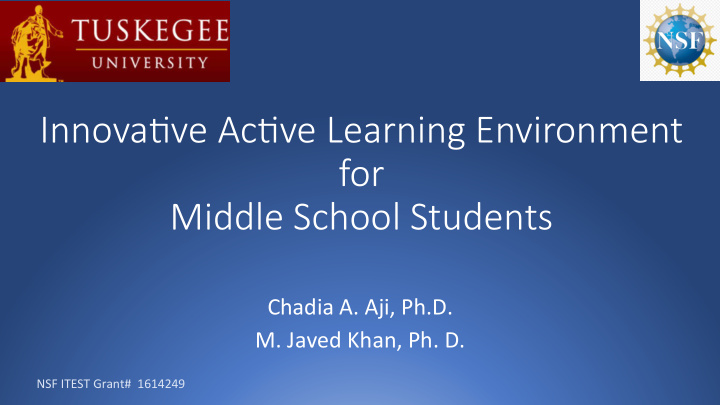



Innova&ve Ac&ve Learning Environment for Middle School Students Chadia A. Aji, Ph.D. M. Javed Khan, Ph. D. NSF ITEST Grant# 1614249
Outline • Background • Target populaJon • Project DescripJon • Results & Discussion
Target Popula&on • 7-8 grades students from groups underrepresented in STEM • Rural school district • 97% populaJon African American (State – 33%, US – 15%) • Only 60% classes taught by highly qualified teachers • Economically depressed communiJes • Median Household Income: 60 th /67 CounJes • Students eligible for free or reduced lunch: 68%, State 51%
AL State Educa&on Report Card • NaJonal Assessment of EducaJonal Programs Report (2016) 8 th Grade Below Basic At Basic At Proficient At Advanced All 44% 38% 14% 3% URM 67% 28% 4% - • Career and Technical EducaJon: 6% passed AHSGE Math component • Math Performance at or above proficient Elementary Middle High AL 48% 38% 27% Project 31% 13% 5% PopulaJon • Only 2.7% take SAT (State - 27%)
Project Descrip&on • Goal • Engage, moJvate and increase the self efficacy of middle school students in STEM through the use of an innovaJve acJve learning environment • ObjecJve • Develop teaching/learning modules for 7-8 grade math/science concepts aligned with AL COS using flight simulaJon sofware.
Why Flight Simula&on SoEware? Engaging RealisJc MoJvaJng
Approach • IdenJfy challenging concepts through meeJngs with school teachers • Determine compaJbility of idenJfied concepts with flight sim acJviJes • Develop lesson plans, acJviJes (paper/pencil and flight sim) • Conduct professional development for teachers (one-week) • Refine lesson plans/acJviJes based on teacher feedback • Conduct summer camp for 7-8 grade students (one-week)
Typical Lesson • Basics • Paper/Pencil acJvity • Flt Sim acJvity • Mission • Data ExtracJon • Data Plohng • Data Analysis
Assessment Instruments • Teachers Pre/Post Ahtude Surveys (MTEBI, STEBI) • Students Pre/Post Content Tests • Students Pre/Post Math and Science Ahtude Surveys • Teachers Post Camp Survey • Students Post Camp Survey
Characteris&cs of Our Model • AcJve learning • ConnecJon between classroom and real life • Group acJvity • Near-peer mentoring by undergraduate students
Qu Ques&ons?
Recommend
More recommend